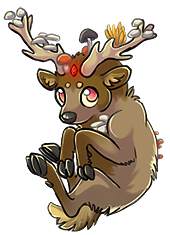|
155 POSTS
|
ʡ 170
|
|
Female
|
59 Cycles
|
|
Sungazer Lizard
|
Lizz
|
|
Jan 21 2021, 10:21 PM
(This post was last modified: Jan 27 2021, 09:23 AM by Sharp.)
Technology in Origin Cave is a strange and highly variable beast. One gembound may sit in an ornate palace, sipping tea from a goblet, while another fights for scraps with red rats. Overall, most characters rarely advance beyond the Stone Age, though there are plenty of breakout inventors willing to go above and beyond in the name of progress. Here's a gallery of their accomplishments, sorted by basic function.
Title: What the object is called.
Inventor(s): If you don't know, put 'N/A' or the names of known crafters.
Usage: Weaponry / Defense / Shelter / Clothes / Food / Recreation / Transportation / Utility -- What the thing does.
Availability: Is the recipe widely shared? Only known by those close to the craftsman? Top secret?
Difficulty: Crude / Basic / Intermediate / Advanced / Highly Advanced -- how hard on average it is to craft this item. Typically concides with tehnological advancement.
Requires: Needed tools, spells, etc.
Description: What it is and how to make it. Try to keep it simple!
Not all tools are created equal, and some may be limited to size, dexterity, or species. Feel free to play around with designs to help them fit your character.
Weaponry
If you're lucky, you're born with sharp claws and fierce magic. If you're not, you'll have to rely on your wits to win a fight-- or, skip all the thinking and just grab a knife. Even the strongest gembound can benefit from a weapon, letting them strike faster, stronger and further away, rivaling the most powerful spells.
Hand Axe
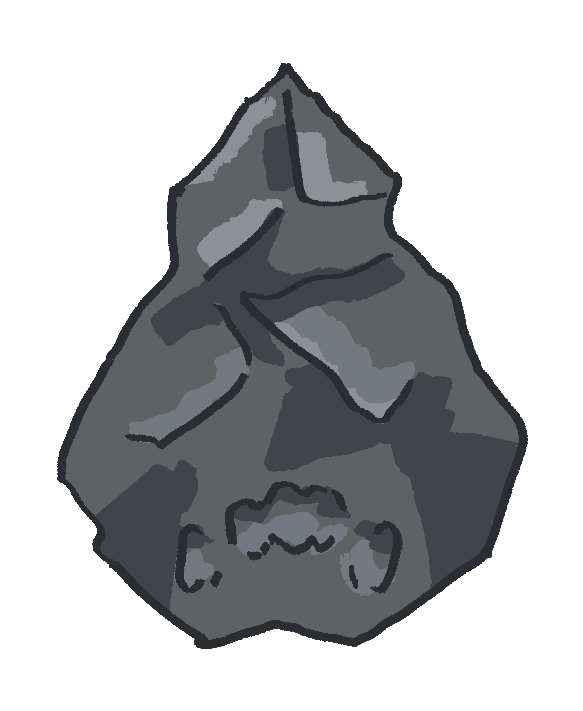 Inventor(s)
Inventor(s): N/A
Availability: Common
Difficulty: Crude
Requires: Stone
A hand axe (also called simply a "blade" or "pointy stone") is a primitive, easily-made weapon for generalized use. All you need is a sharp but easy-to-break stone like flint. Chip away at the surface with strong and defined strikes with a smaller rock until you get a sharpened point on one end. From there you can use it as it is, attach it to a spear or arrow, or cut extra grooves into it for different purposes.
While it lacks in precision and grace, the hand axe makes up for this with its incredible versatility. Even non-opposable animals can use one with the right design and a lot of practice, though construction will still be difficult without magic.
Sling
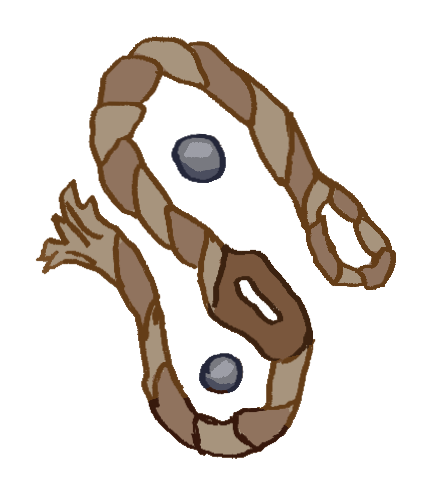 Inventor(s)
Inventor(s): Sharp
Availability: Uncommon
Difficulty: Basic
Requires: Rope
A sling is a simple long-range weapon for those with hands or strong jaws. Two ropes come from either side of a slitted pouch where a small projectile is held. Simply grab both ends and swing it around, and once you've reached a good velocity, let go of one end while thrusting forward. Experienced slingers can throw up to a thousand feet and infuse their bullets with poison or magic.
Construction is easy: simply take a long rope-- braided twine works best, but any vine will do-- and slit it in the center, pulling it apart slightly so it can hold a bullet. Tie a loop on one end to hold. Projectiles can be made of anything, from stones to hardened clay to crystals, or be magical in nature. Optional addons include padded grips, slits made of other materials, or attaching the sling to a pole (staff slings).
Spear
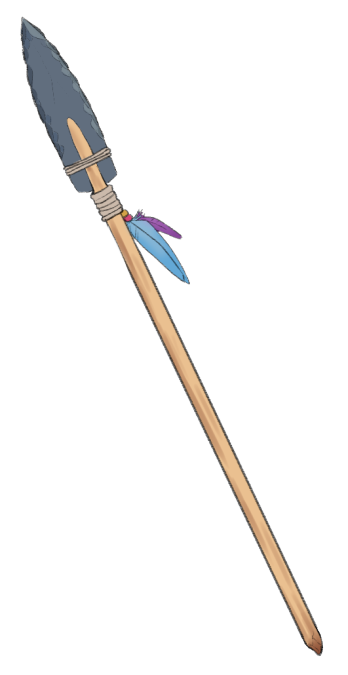 Inventor(s)
Inventor(s): V-Chaos-Two, Sergei, Others
Availability: Only known by those close to the craftsman (though can be easily replicated by others).
Difficulty: Basic
Requires: Shale rock, straight branch (with twigs removed), twine/vine, heavy stone.
Image credit to Charlie!
Description: A long spear made of shale rock for the tip, a smooth, straight branch for the shaft, and twine to hold it all together. With added decoration (can be made with beads, feathers, or metal). Used to fight with, spear fish or prey with, and even finds use as a walking staff.
To craft: Take the shale piece and, using a heavy stone, crack off outer pieces to make an edge until you have a spade-like shape. For the shaft, break off any twigs and remove the bark (optional) off a branch and split in half with your new spear tip near the top. Push the split end onto the bottom of the spade tip and use twine/vine to secure (for extra stability, use a small rock to create divots on either side for the twine to stay secure on, and carve divots in the splits of the shaft too). Once finished, you can add a grip using more tied twine or leather, decoration, carve it, or leave it as is. It's a highly customizable weapon.
Defense
Now, no-one wants to be on the receiving end of a nasty blade. That's where defenses-- armor, shields, antidotes, and the like-- come in. They can overlay existing biological protection, guard you in the thick of battle, or simply be something shiny to show up to a quest in.
Shelter
Most gembounds get by fine with a small hole in the ground or a nest in the trees. But if you want to build your dens bigger, grander, or simply cozier, engineering is the place to look.
Cement
Inventor(s): Revealed by the Collector
Availability: Check with Dip
Difficulty: Advanced
Requires: Shells or porous rock, clay, water, mixing tool
This simple cement is formed by a mix of powdered shells or porous rock mixed with clay and water. It dries into a hardened, rock-like substance, and can be used to shape shelters or bind other stones.
Glass
Inventor(s): Revealed by the Collector
Availability: Check with Volta
Difficulty: Highly Advanced
Requires: Certain various stone types, kiln, fuel source, tools
A dazzling clear surface. Glass can be first created and then, with the appropriate tools, even moulded and blown into shape. This is done by heating and treating certain types of mineral, removing impurities, and passing them through progressively cooler furnaces to prevent breakage. Note that most glass won't come out perfectly smooth or transparent without modern technology.
Lumber
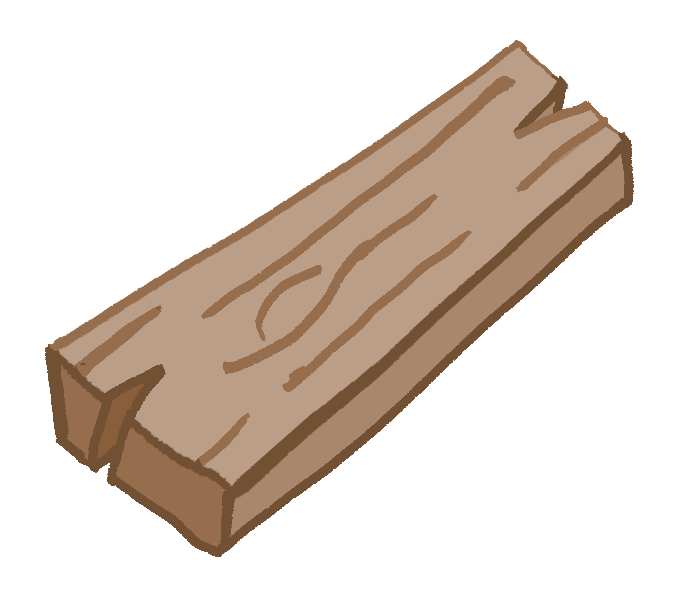 Inventor(s)
Inventor(s): Revealed by the Collector
Availability: Check with Ischium
Difficulty: Intermediate
Requires: Wood, Oils or other treatment materials, cutting implement of some kind
Lumber is essentially wood that has been processed, so it no longer rots as fast and is easier to build with. The knowledge to treat lumber requires first cutting, sanding and drying wood, and then treating it with any form of sealant. This can be a dye, an oil or another concoction made for this purpose.
Clothes
Warmth. Protection. Grandeur. Even secret codes. There's plenty of reasons to wear accessories over your fur (or scales, or feathers), and gembounds have been donning them since the Great Awakening. A good garb can even function as armor or completely change your identity.
Faerie Cloak
Inventor(s): The Court, specifically Walks Like Rain
Availability: Used among the Court and their associates
Difficulty: Intermediate
Requires: Leather or hide, cord
The Faerie's cloak is a simple, cozy garment, though it's sheer size requires a lot of material. Remove the skin of a large animal, like a deer, and stretch out the fur into a big semicircle. Mark out the hood in the center and bunch it up, using some string to keep it in place-- tissue cord from that same body works just fine. When you're ready, leave it to dry a bit, stretch the hood, cut any slits for extra limbs and trim away if needed. A belt may be added around the waist to turn it into a tunic. Faerie cloaks differentiate from other clothes by their magical touch, extra length to accommodate insect body plans, and the unnerving tendency for the inside to still be crusted with blood.
Food
Everyone needs to eat, be it grass or meat or unholy corrupted oil. Some just prefer to do it more... elegantly than others. This section details everything from basic farming, to hunting, to even cooking and food storage for all your hungry needs.
Tea
Inventor(s): Revealed by the Collector
Availability: Check with Dip
Difficulty: Basic
Requires: Dirt, water, container, heat source
The seeds of tea (or other) plants can be grown to harvest their leaves, and these in turn can be crushed or simply steeped in very hot water to create a drink. The tea will depend on the properties of the leaves used to brew it.
Refining Salt
Inventor(s): Revealed by the Collector
Availability: Check with Garnet-Epsilon
Difficulty: Basic
Requires: Heat source, container, salt, water
Though salt water itself is rare in the caves, mineral sources do exist. They can be soaked and then boiled in water until evaporated to leave behind the salt alone.
Sugar
Inventor(s): Revealed by the Collector
Availability: Word of mouth
Difficulty: Basic
Requires: Sugary natural food, water, container, optional heat source
A food additive that packs a sweet punch. Sugary natural foods such as fruits, nectars or honey can be refined into dry sugar. This can be done by pressing the food, then soaking or boiling and evaporating it. It can be boiled, optionally, to remove impurities.
Fruit Rolls
 Inventor(s)
Inventor(s): James
Availability: Known by those close to James (but he's open to teach people)
Difficulty: Basic
Requires: Stone bowl, fire, fruit, a stick.
Image credit to Charlie!
Description: A sweet treat made by simmering fruit juice until it becomes a syrup, then left to dry out on a flat stone.
To craft: Put the bowl over the fire (or make the fire around it) and crush up fruit (either in the bowl or in another bowl) and pick out seeds, skins, and chunky bits until you have a sizable amount of juice. Leave in the bowl over the fire to simmer and bubble, stirring with a stick occasionally to keep it from burning. Once it reaches a gooey, honey-like consistency, pour out onto a flat rock and leave to dry in the light. Once it has dried, use the stick to cut the dry fruit syrup into sections and then push into rolls. Either server as is or on skewers and enjoy!
Recreation
Sometimes you make things just because they're fun. There ain't no shame in that, so we made an entire section just for your pretty art pieces. Fire away!
Straw Doll
Inventor(s): Pip
Usage: Recreational
Availability: Widespread, Pip would share, and its rather easy
Difficulty: Basic
Requires: Straw
Description: A simple doll, usually made of nothing but straw. While the body is a large clump of straw, as a brush would be, the arms and face must be either be braided or have the ends tied with string. Larger/more skilled gembound might be able to give it a wooden face and center. Highly customizable. Dyes and accessories like feathers can be added to the basic doll to give it more personality.
Dye
Inventor(s): N/A
Availability: Common
Difficulty: Basic
Requires: Container, other materials depend on the type
Dyes are a way for gembounds to change something's color, texture, or even scent. See the Known Dyes and Ingredients List for more.
Transportation
The caves are huge, and while you can cover most of it on foot, wing, or fin, sometimes all you want is an extra artificial push.
The Wheel
Inventor(s): Revealed by the Collector
Availability: Word of mouth
Difficulty: Intermediate-Advanced
Requires: Wood or other suitable material, cutting or shaping implements, etc.
This knowledge grants the skills needed (or at least the basic concepts required) for making wheels, as well as axles, and setting them to simple vehicles such as carts. Simpler varieties include solid wooden or stone circles with a hole in the center. Building on this, one could create some fascinating inventions of their own.
Boat
Inventor(s): Revealed by the Collector
Availability: Check with Rainstorm
Difficulty: Advanced
Requires: Wood, Cutting and Shaping Implements
Simple but vital structures ranging from hollowed-out logs to waterproof kayaks, boats are integral to water transportation. Designs vary but typically consist of a domed, hollow shape, carved out of a light material like wood. Paddles— flat rectangles attached to sticks, essentially— can be used to steer it, or fabric sails, or even pure manpower.
Cart
Inventor(s): Sharp
Availability: Willing to teach anyone who knows her
Difficulty: Advanced
Requires: Wheels, building material of some kind like bone
While very crude by modern standards, Sharp's carts are one of her greatest prides and very useful for carrying stuff. Arrange bones or wood into an interlocking, flat platform, with deep grooves on the bottom to accomodate 2-4 wheels. Repeat the pattern without grooves for four walls and connect them to the base using corner joints or adhesive. Take your wheels again, slip them on the ends of long straight rods in pairs, and carefully fit those into the nicks on your box. Finally, attach a rod-and-bar, rope, or other handle to the front, and you're ready to go.
While carts don't require expensive or hard-to-find materials, the technique needed to make them is delicate, and improperly-built ones are prone to breaking.
Utility
Inventions that serve a purpose that do not fit into the other categories.
Rope
Inventor(s): N/A
Availability: Widespread
Difficulty: Crude
Requires: Vines, plant fiber, tissue cords, or wool
A rope is a very simple tool used alone or with other gadgets. Simply take a few long vines, grasses, or other strings and twist or braid them together until it's stronger than the original twine. Rope can be used to tie down objects, connect two structures, provide support, or even bring harm by cracking it like a whip.
Drawstring Bag
 Inventor(s)
Inventor(s): James
Availability: Known by those close to James (but he's open to teach people)
Difficulty: Basic
Requires: Vines/twine, leaves/leather
Image credit to Charlie!
Description: A simply made bag with a drawstring top, overlapped twine/vine pieces, and a bottom and siding made from either leaves or leather.
To craft: Lay ten pieces of vine or twine about half a hoof (or three finger lengths) apart from one another, and then lay ten more pieces of vine perpendicular to the other ten, making twenty in total. For extra stability, weave each of these pieces like a lattice, under and over in alternating patterns down the first ten pieces' lengths. Then tie each place where the vines intersect in a cross to keep them from going anywhere. Then loop the ends of each piece of vine/twine and tie before looping onto a long piece of twine, vine, or thin leather and tie it into it's own loop. Now you have the bag and the drawstring. Next, layer the bottom in sides in leaves or leather to make sure anything you put inside won't fall out, and you have a bag.
You can carry this around your neck, hold it, or even make it into a satchel or backpack.
Paper
Inventor(s): Revealed by the Collector
Availability: Check with Garnet-Epsilon
Difficulty: Advanced
Requires: Frame press, plant fibers, water
Basic parchment-type paper is used for writing, decoration or other uses. It's made by separating plant fibers like bark from the rest of the plant, beating it down to a pulp, then suspending it in a wet screen and pressing the water out. Repeating this process and drying the result creates a crude type of paper. Additions like dye or flowers are added before the screening to change the paper's properties.
Siphon
Inventor(s): Revealed by the Collector
Availability: Check with Volta
Difficulty: Basic
Requires: Any tube-like structure
A siphon can be used to move water from a higher elevation to a lower. Any tube--ex. a flexible reed--can be filled with water, with one end then inserted into each body of water; as it drains out via gravity alone, more water will be sucked from the higher water source to replace what's drained, creating a steady, draining flow.
Leather Tanning
Inventor(s): Revealed by the Collector, Various Others
Availability: Widespread
Difficulty: Basic
Requires: Animal skins, water, preferably oils
Leather is a general material for a multitude of purposes that can be tanned by beating and treating drying skins. A suitable hide is picked clear of hairs, cleaned, stretched out to dry, and finally optionally dyed. There are lots of different leather-making methods that create different results, ranging from incredibly hard armor (soaking the leather in vegetable oils while it dries and later submerging it in boiling water) to soft and supple (soaking it in fish oil instead).
Circuitry
Inventor(s): Revealed by the Collector
Availability: Check with Aran
Difficulty: Highly Advanced
Requires: Conductive objects, a Power Source
A very simple electrical circuit can be completed by making a closed metal loop between an electrically charged object and a second object, such as a light bulb, that will react to the electrical charge. Extra care must be taken so that the wire doesn’t get trampled, damaged or wet.
Kiln
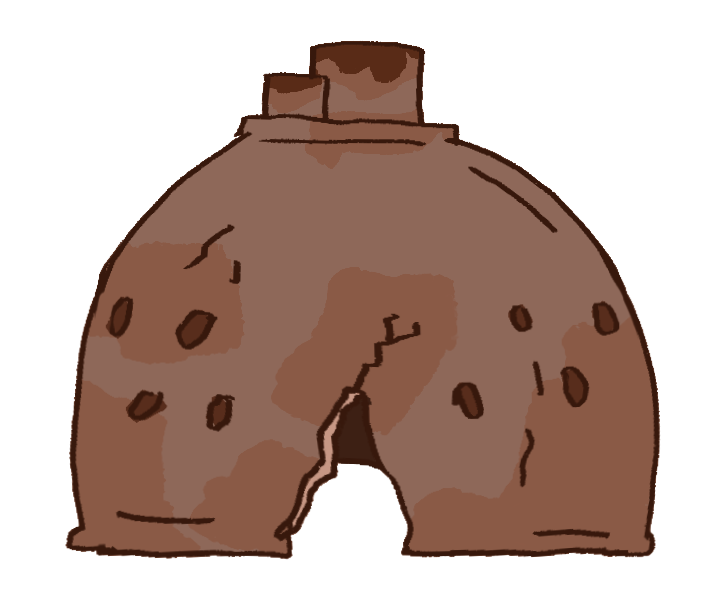 Inventor(s)
Inventor(s): Revealed by the Collector
Availability: Word of Mouth
Difficulty: Advanced
Requires: Clay, stone or similar, heat sources, fuel
A kiln is a complex "stove" of sorts that lets you heat up things to incredible temperatures. Arrange stone or clay bricks into a large dome shape, with an entrance slot and small, pluggable holes to regulate temperature. Charcoal or other fires are used to heat the interior with an empty space above for doing anything from cooking meat to drying pottery. Multiple designs are possible depending on intent and resources.
Glass
Inventor(s): Revealed by the Collector
Availability: Check with Volta
Difficulty: Highly Advanced
Requires: Certain various stone types, kiln, fuel source, tools
A dazzling clear surface. Glass can be first created and then, with the appropriate tools, even moulded and blown into shape. This is done by heating and treating certain types of mineral, removing impurities, and passing them through progressively cooler furnaces to prevent breakage. Note that most glass won't come out perfectly smooth or transparent without modern technology.
Pottery
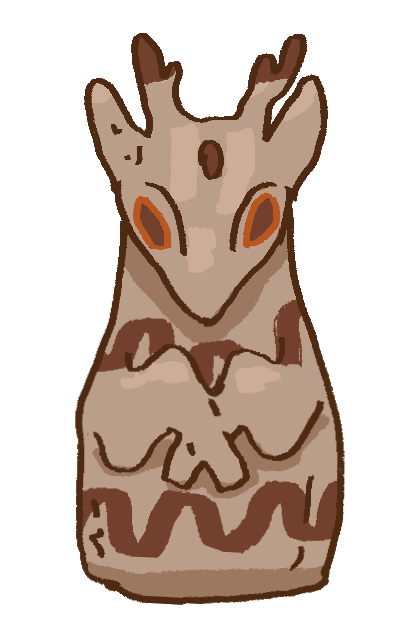 Inventor(s)
Inventor(s): Revealed by the Collector, Others
Availability: Widespread
Difficulty: Advanced
Requires: Clay, kiln, heat source
Clay can be gathered from streams and lumped together before being molded softly. When you’re ready these can be left in the sun to dry, or— if you want strong, usable pottery— baked in a kiln to dry. Designs can be painted beforehand in dye or special particles mixed into the clay for extra effect.
Pottery is highly useful in creating basic building blocks like brick, but also storage containers, animal traps, decorative vases and other such things.
Weaving
Inventor(s): Revealed by the Collector
Availability: Check with Haven or Sorda
Difficulty: Advanced
Requires: Needle, thread, fabric, optional loom (wood, fabric)
A needle--formed of bone, metal, wood etc.--can be threaded with any cord, such as spider-silk or thin gut, and used to sew together other cloth materials. This can be used to make shelter, clothing, and more. A Loom can be used to additionally weave fabric into a base shape from components like wool or silk, to begin with.
To add your own tools, simply respond with the code below:
Code:
<div class="gmpost"><b>Title</b>
<b>Inventor(s)</b>:
<b>Usage</b>:
<b>Availability</b>:
<b>Difficulty</b>:
<b>Requires</b>:
<hr>
Description
</div>
|
|
| |
|
530 POSTS
|
ʡ 10
|
|
They/them
|
56 Cycles
|
|
Valkhound
|
Charlie
|
|
Jan 21 2021, 10:53 PM
(This post was last modified: Jan 21 2021, 10:56 PM by Maximus.)
Spear
Inventor(s): V-Chaos-Two
Usage: Weaponry - Used to fight with, spear fish or prey with, and even finds use as a walking staff.
Availability: Only known by those close to the craftsman (though can be easily replicated by others).
Difficulty: Basic
Requires: Shale rock, straight branch (with twigs removed), twine/vine, heavy stone.
Description: A long spear made of shale rock for the tip, a smooth, straight branch for the shaft, and twine to hold it all together. With added decoration (can be made with beads, feathers, or metal).
To craft: Take the shale piece and, using a heavy stone, crack off outer pieces to make an edge until you have a spade-like shape. For the shaft, break off any twigs and remove the bark (optional) off a branch and split in half with your new spear tip near the top. Push the split end onto the bottom of the spade tip and use twine/vine to secure (for extra stability, use a small rock to create divots on either side for the twine to stay secure on, and carve divots in the splits of the shaft too). Once finished, you can add a grip using more tied twine or leather, decoration, carve it, or leave it as is. It's a highly customizable weapon.

|
|
| |

|
Here are the items revealed through the Collector thread here. Most would do well in a "utility" category but for now I just stuck 'em in Other! Add whichever you want; edit as you see fit!
Tea
Inventor(s): Revealed by the Collector
Usage: Food
Availability: Check with Dip
Difficulty: Basic
Requires: Dirt, water, container, heat source
The seeds of tea (or other) plants can be grown to harvest their leaves, and these in turn can be crushed or simply steeped in very hot water to create a drink. The tea will depend on the properties of the leaves used to brew it.
Lumber
Inventor(s): Revealed by the Collector
Usage: Other
Availability: Check with Ischium
Difficulty: Intermediate
Requires: Wood, Oils or other treatment materials, cutting implement of some kind
The knowledge to treat lumber requires first cutting, sanding and drying wood, and then treating it with any form of sealant. This can be a dye, an oil or another concoction made for this purpose.
The Wheel
Inventor(s): Revealed by the Collector
Usage: Other
Availability:
Difficulty: Word of mouth
Requires: Wood or other suitable material, cutting or shaping implements, etc.
This knowledge grants the skills needed (or at least the basic concepts required) for making wheels, as well as axles, and setting them to simple vehicles such as carts. Building on this, one could create some fascinating inventions of their own.
Paper
Inventor(s): Revealed by the Collector
Usage: Other
Availability: Check with Garnet-Epsilon
Difficulty: Advanced
Requires: Frame press, plant fibers, water
Basic parchment-type paper is used for writing, decoration or other uses. It is made by beating plant fibers into a pulp, then suspending this in water before pressing the water out. Repeating this process and drying the result creates a crude type of paper. Additions like dye can change the paper's properties.
Siphon
Inventor(s): Revealed by the Collector
Usage: Other
Availability: Check with Volta
Difficulty: Basic
Requires: Any tube-like structure
A siphon can be used to move water from a higher elevation to a lower. Any tube--ex. a flexible reed--can be filled with water, with one end then inserted into each body of water; as it drains out via gravity alone, more water will be sucked from the higher water source to replace what's drained, creating a steady, draining flow.
Tanning
Inventor(s): Revealed by the Collector, Various Others
Usage: Other
Availability: Widespread
Difficulty: Basic
Requires: Animal skins, water, preferably oils
Leather can be tanned by beating and treating drying skins. Depending on method, leather can be soft and supple, or tough and water-resistant.
Circuitry
Inventor(s): Revealed by the Collector
Usage: Other
Availability: Check with Aran
Difficulty: Highly Advanced
Requires: Conductive objects, a Power Source
Metal wires connected to a power source can power a small light orb (or any other electrically-powered object) by completing a circuit.
Boat
Inventor(s): Revealed by the Collector
Usage: Other
Availability: Check with Rainstorm
Difficulty: Advanced
Requires: Wood, Cutting and Shaping Implements
Ranging from hollowed-out logs to waterproofed boats with sails or oars, boats provide water transport anywhere in the caves.
Cement
Inventor(s): Revealed by the Collector
Usage: Other
Availability: Check with Dip
Difficulty: Advanced
Requires: Shells or porous rock, clay, water, mixing tool
This simple cement is formed by a mix of powdered shells or porous rock mixed with clay and water. It dries into a hardened, rock-like substance, and can be used to shape shelters or bind other stones.
Refining Salt
Inventor(s): Revealed by the Collector
Usage: Food
Availability: Check with Garnet-Epsilon
Difficulty: Basic
Requires: Heat source, container, salt, water
Though salt water itself is rare in the caves, mineral sources do exist. They can be soaked and then boiled in water until evaporated to leave behind the salt alone.
Kiln
Inventor(s): Revealed by the Collector
Usage: Other
Availability: Word of Mouth
Difficulty: Advanced
Requires: Clay, stone or similar, heat sources, fuel
Stone or clay bricks can be arranged to create a kiln to focus heat. Charcoal or other fires are used to heat the interior, and depending on the shape and temperature one can do anything from dry meat to bake clay.
Glass
Inventor(s): Revealed by the Collector
Usage: Other
Availability: Check with Volta
Difficulty: Highly Advanced
Requires: Certain various stone types, kiln, fuel source, tools
Glass can be first created and then, with the appropriate tools, even moulded and blown into shape. This is done by heating and treating certain types of mineral, removing impurities, and passing them through progressively cooler furnaces to prevent breakage.
Pottery
Inventor(s): Revealed by the Collector, Others
Usage: Other
Availability: Widespread
Difficulty: Advanced
Requires: Clay, kiln, heat source
Clay can be shaped into various designs, baked in a kiln or in another strong heat source, and then painted or polished for additional decoration. Pottery can be used to store food or carry liquids, and so on.
Sugar
Inventor(s): Revealed by the Collector
Usage: Food
Availability: Word of mouth
Difficulty: Basic
Requires: Sugary natural food, water, container, optional heat source
Sugary natural foods such as fruits, nectars or honey can be refined into dry sugar. This can be done by pressing the food, then soaking or boiling and evaporating it. It can be boiled, optionally, to remove impurities.
Weaving
Inventor(s): Revealed by the Collector
Usage: Other
Availability: Check with Haven or Sorda
Difficulty: Advanced
Requires: Needle, thread, fabric, optional loom (wood, fabric)
A needle--formed of bone, metal, wood etc.--can be threaded with any cord, such as spider-silk or thin gut, and used to sew together other cloth materials. This can be used to make shelter, clothing, and more. A Loom can be used to additionally weave fabric into a base shape from components like wool or silk, to begin with.
| |
|
| |
|
828 POSTS
|
ʡ 42
|
|
Stallion, nonbinary.
|
59 Cycles
|
|
Thoroughbred Pegasus
|
Charlie
|
|
Jan 21 2021, 11:30 PM
(This post was last modified: Jan 21 2021, 11:32 PM by James.)
Fruit Rolls
Inventor(s): James
Usage: Food
Availability: Known by those close to James (but he's open to teach people)
Difficulty: Basic
Requires: Stone bowl, fire, fruit, a stick.
Description: A sweet treat made by simmering fruit juice until it becomes a syrup, then left to dry out on a flat stone.
To craft: Put the bowl over the fire (or make the fire around it) and crush up fruit (either in the bowl or in another bowl) and pick out seeds, skins, and chunky bits until you have a sizable amount of juice. Leave in the bowl over the fire to simmer and bubble, stirring with a stick occasionally to keep it from burning. Once it reaches a gooey, honey-like consistency, pour out onto a flat rock and leave to dry in the light. Once it has dried, use the stick to cut the dry fruit syrup into sections and then push into rolls. Either server as is or on skewers and enjoy!

Drawstring Bag
Inventor(s): James
Usage: Utility
Availability: Known by those close to James (but he's open to teach people)
Difficulty: Basic
Requires: Vines/twine, leaves/leather
Description: A simply made bag with a drawstring top, overlapped twine/vine pieces, and a bottom and siding made from either leaves or leather.
To craft: Lay ten pieces of vine or twine about half a hoof (or three finger lengths) apart from one another, and then lay ten more pieces of vine perpendicular to the other ten, making twenty in total. For extra stability, weave each of these pieces like a lattice, under and over in alternating patterns down the first ten pieces' lengths. Then tie each place where the vines intersect in a cross to keep them from going anywhere. Then loop the ends of each piece of vine/twine and tie before looping onto a long piece of twine, vine, or thin leather and tie it into it's own loop. Now you have the bag and the drawstring. Next, layer the bottom in sides in leaves or leather to make sure anything you put inside won't fall out, and you have a bag.
You can carry this around your neck, hold it, or even make it into a satchel or backpack.

|
|
| |
|
178 POSTS
|
ʡ 0
|
|
Genderless, goes by she/her
|
73 Cycles
|
|
Brahma chicken
|
Gortie
|
|
Jan 22 2021, 04:36 AM
(This post was last modified: Jan 22 2021, 04:38 AM by Kalama.)
Straw Doll
Inventor(s): Pip
Usage: Recreational
Availability: Widespread, Pip would share, and its rather easy
Difficulty: Basic
Requires: Straw
Description: A simple doll, usually made of nothing but straw. While the body is a large clump of straw, as a brush would be, the arms and face must be either be braided or have the ends tied with string. Larger/more skilled gembound might be able to give it a wooden face and center. Highly customizable. Dyes and accessories like feathers can be added to the basic doll to give it more personality.
|
|
| |
|

